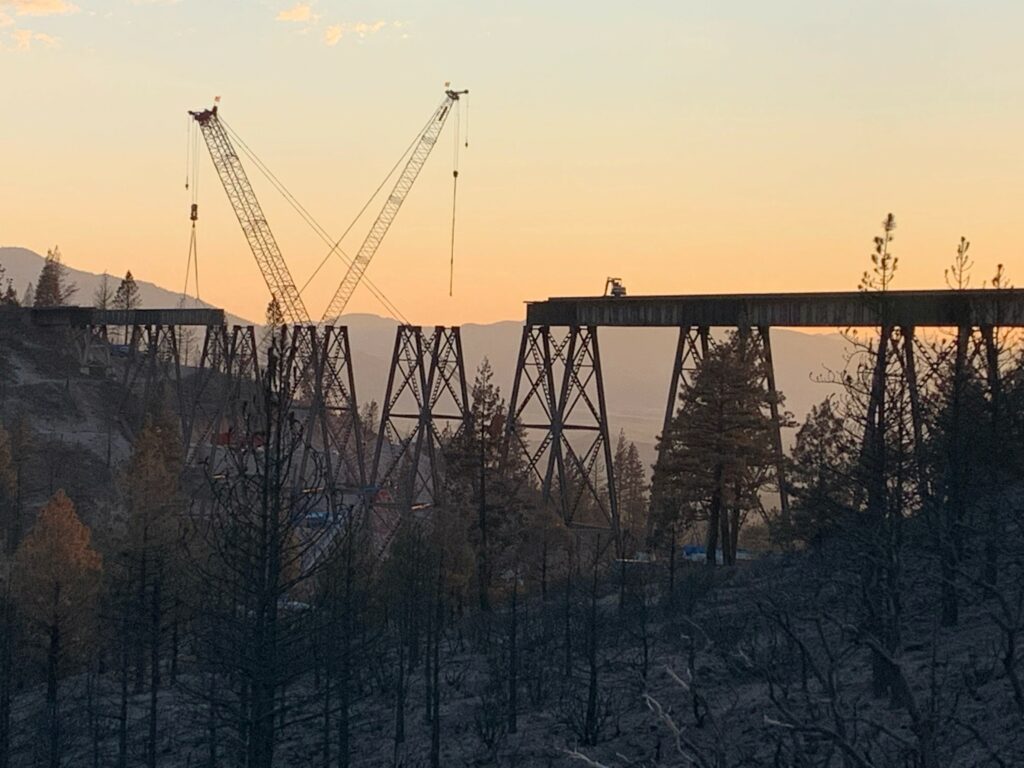
Independent analyst Anthony B. Hatch is fond of saying that one of freight railroads’ enduring advantages is owning and maintaining their own infrastructure. Nothing could drive that point home better than the repair blitz that Union Pacific launched after its 1,200-foot Dry Canyon Bridge sustained heavy damage from a wildfire.
The 150-foot-tall span in Hotlum, Calif., in the shadow of Mount Shasta, was caught in the path of the Lava Fire on June 28. The inferno put the bridge out of service, and UP estimated its I-5 Corridor linking California and the Pacific Northwest would be severed until around Sept. 1.
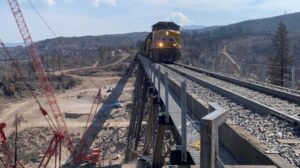
Instead, UP Engineering Department employees and an army of contractors rebuilt the bridge in 34 days, allowing trains to resume rolling on Aug. 1 – and ending a roundabout detour via Salt Lake City. In all, UP detoured 221 trains, which added more than 200,000 train miles and lengthened transit times by 48 to 72 hours during the closure.
You have to be impressed by how crews were able to rebuild the bridge quickly and safely. By any measure it was a Herculean task. They had to build roads to the floor of the canyon so three massive cranes could be set up. Only one of the bridge’s 19 spans escaped damage, so crews installed nine new spans and heat-straightened another nine to repair warping caused by the fire. Ballast deck pans were added, along with 700 new ties and new rail. Some 58 tons of new steel were used to rebuild the bridge.
DOT does not stand for ‘Done On Time’
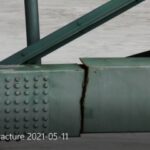
Now compare UP’s response to the sad case of the Hernando DeSoto Bridge, which carries Interstate 40 over the Mississippi River at Memphis. A May 11 inspection of the bridge revealed what inspections going back to 2016 had not: A large crack in the bottom of a critical steel support beam. The bridge was shut down immediately and officials from the Tennessee and Arkansas departments of transportation began drawing up repair plans.
Some 82 days later, the I-40 bridge was reopened to traffic — coincidentally on Aug. 1, the same day as UP’s Dry Canyon Bridge. Yes, state highway crews and contractors took more than twice as long to make repairs that seem a lot less involved. (Don’t take my word for it. See this Tennessee DOT video with oddly cheerful music.)
Freight railroads get high marks
Compared to Class I railroads’ main lines, all other U.S. infrastructure seems to be a shambles. The American Society of Civil Engineers 2021 Report Card for America’s Infrastructure ranged from a high of B in rail to a low of D- in transit.
Not all railroads are created equal, of course. The report card points out the stark differences between the strong freight rail system and the threadbare publicly financed passenger and commuter networks. The passenger and commuter lines require $45.2 billion to bring them into a state of good repair. Exhibit A would be the backlog of repair projects on Amtrak’s Northeast Corridor, including the need to build new tunnels beneath the Hudson River.
Roads earned a D, indicating that they are in fair to poor condition, mostly below standard, and carry a strong risk of failure. This should surprise no one. The only thing more gridlocked than some interstate highways is Congress. Lawmakers have not raised the federal gas tax since 1993, maintenance costs have risen, and the Highway Trust Fund has been in the red for more than a decade. The infrastructure bill that just passed the Senate is a drop in the bucket. Meanwhile, trucks continue to pound highways into oblivion without paying their fair share.

As highway congestion increases, the freight railroads’ self-financed infrastructure will become even more of an advantage than it is today. Unlike highways, main lines have never been in better shape. It doesn’t take an act of Congress to add a siding or double track, meaning railroads can expand capacity virtually at will. Building new intermodal terminals remains challenging due to local opposition, but that same NIMBY effect clouds highway projects, too.
This summer’s wildfires, which damaged track and bridges at several locations in the western U.S. and Canada, illustrate the importance of being nimble.
Rick Paterson, a railroader turned analyst at Loop Capital Markets, says climate change means railroads will have to be even better prepared in the years ahead. “It’s important to remember that railroads are not just transportation companies, but also very good engineering companies,” he says. “Unfortunately, the engineering components are going to have to raise their game from ‘very good’ to ‘great’ as they increasingly play whack-a-mole with damaged infrastructure on the back of extreme weather events.”
You can bet that the Class I railroads will be up to the task.
You can reach Bill Stephens at bybillstephens@gmail.com and follow him on Twitter @bybillstephens






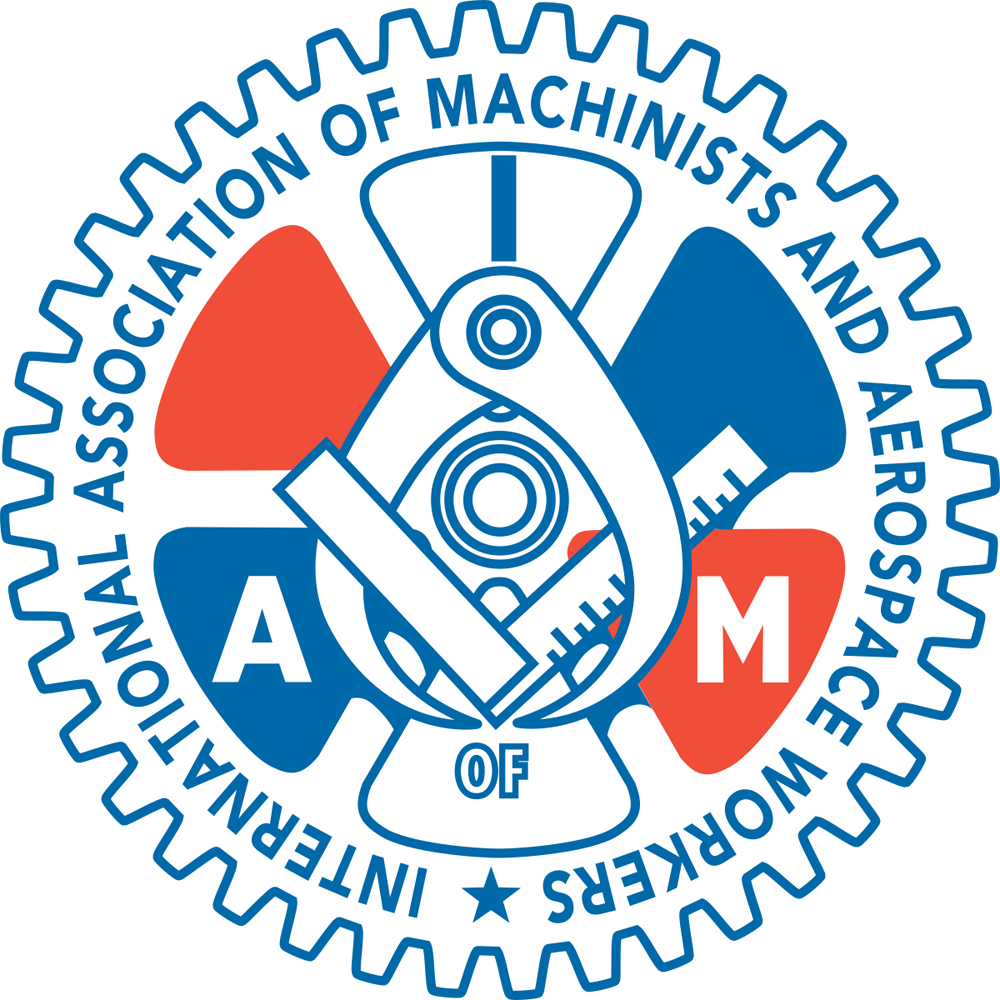
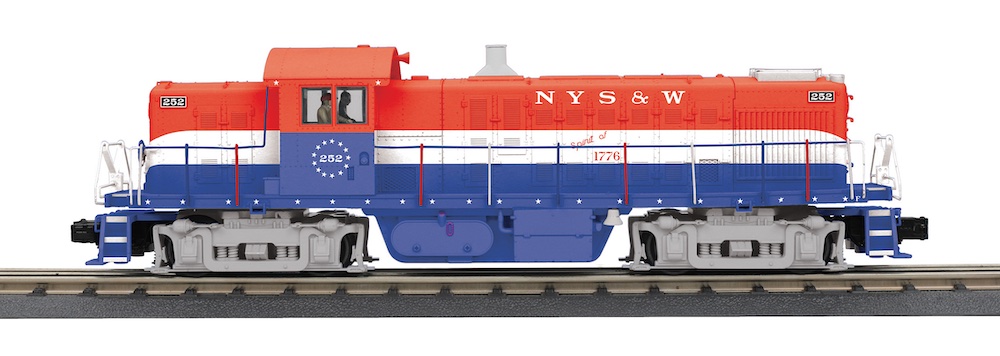
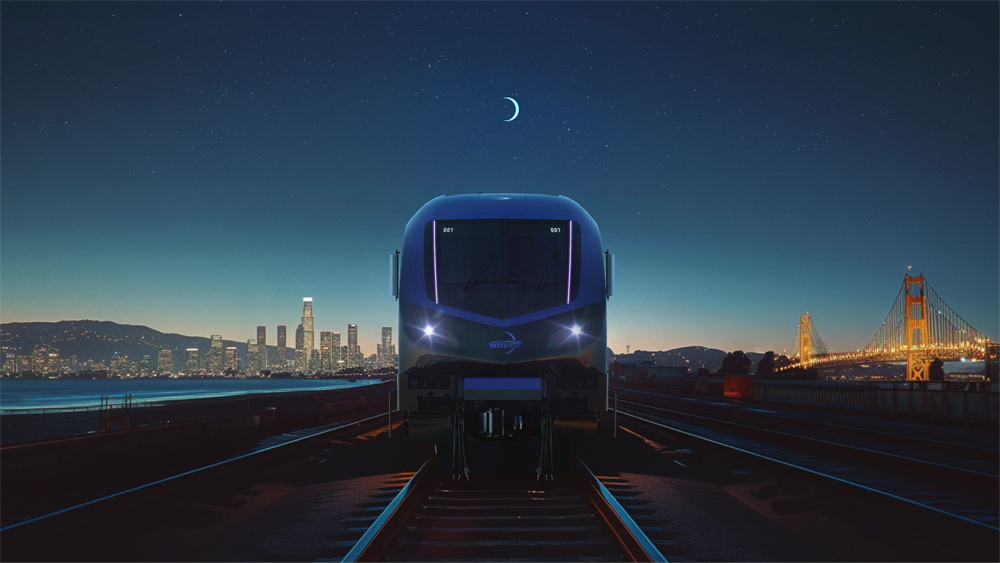
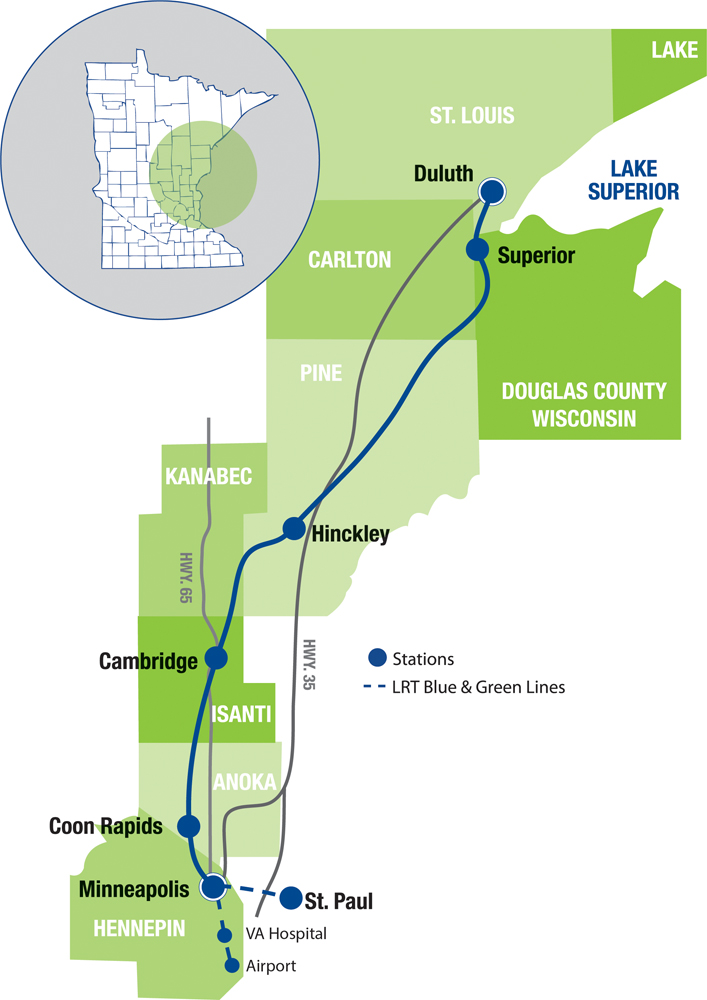




Bill,
Yes the railroads and their contractors do a great job in recovering from unplanned incidents. Having worked as a railroad manager in the field there is quite an adrenaline rush to get damage fixed and operations running again. Now we need to address the risk side of the business. Bridges of any construction in forest areas should be cleared of fire fuel and maintained that way. (i know you need to get government support to do this and should be part of the FRA safety protocol. Wood bridges in any location should be kept cleared underneath-this situation always has several examples of bridges lost to fire every year. Example BNSF transcon wood bridge close to Waynoka, OK burning down this week. This should be a part of every Engineering group business train inspection trip to observe and for the structures group to manage. Managing water-the real enemy of rail operations deserves an even bigger level of management. Landslides-we are stuck with them.
Jim Wilson
Great story.
The true point here is that UP has the ability to react to a major outage and bring the necessary resources in to quickly and efficiently rebuild as needed.
Rail in the US has a wide variety of problems. Sure, where something needs to be done entirely on the property of a well run major railroad, it tends to happen fairly quickly and efficiently UNLESS local interests prefer to stop it – whether for environmental, NIMBY or other reasons. Public transit and commuter rail fight a myriad of problems, starting with incompetence, NIMBY, nepotism and other corruption, incredibly bad union contracts or state work rules designed to overemploy and under utilize the labor. On LIRR’s ESA project, a TBM had several times as many workers assigned to it as could actually be used. In one case, there were 200 people being paid who had no possible work to do. Poor project management makes it even worse. Use of low bidders who have a poor ‘track’ record.
But kudo’s to UP for getting this right.
In the USA vs EU projects costs 60% more due to decision delays, environmental reviews time eaten up by permitting process and in many cases legal action.
Good to see an industry that can fix their infastructure on their own without crying for federal aid.
That Union Pacific was able to repair the trestle so quickly is truly impressive. And thank goodness they were able to get this route reopened. BNSF’s Inside Gateway route between the Pacific Northwest and California is now closed due to the huge Dixie fire and they are rerouting their trains on the newly opened UP route.
To clarify, I meant to say the eastern side of Hinsdale at the Hinsdale/Western Springs line.
MARK -The I-294 Tri-State Tollway is in Western Springs (Cook County). Hinsdale (DuPage County) starts a couple of blocks west.
We are a two-car, two-IPass family. I’m simply astounded at the work on the tri-state tollway – another example being the interchange a few years back with I-57. Like it or not, rail advocates, the Tollway moves a heckuva lot of people and cargo. At a cost of being rebuilt every 25 years or so, each time to higher capacity at higher standards at you cannot imagine the increase in dollars.
Like railroads, the I-System was built to different standards. Here in Wisconsin, roads seem to last about forty years before crumbling to the subgrade. In contrast, roads in Massachusetts last forever. Having been driven last month in all three directions from the Braintree Split – west to Needham, north to Milton, east to Weymouth – almost nothing has changed since I was driven over those roads when they opened in the late 1950’s and early 1960’s. A couple of new ramps at Braintree/ Quincy Adams, a handful of the bridges replaced, all else is as built sixty years ago – right down to the lack of beam guard along spiral ramps. Yes, the Big Dig in downtown Boston was a total rebuild, but driving south on Route I-93 even before you leave the Boston city limit you’re back to 1958 or 1959.
The problem with highways is an endless spiral of increasing costs (as with the Big Dig). Higher traffic engineering standards, higher capacity, higher material prices, and the staggering cost of staging under traffic, mean that there is no solution.
Mr. Stephens, regarding your statement “railroads can expand capacity virtually at will”, would that that be so all the time. Or do we distinguish between publicly-owned and privately-owned railroads. Let me remind of what I refer to as “The Battle of Glenview, IL”. Now it’s true what was to be the first phase of triple-tracking the Metra Milw. North/CP C&M Sub Rondout-Tower A5 is railroad publicly-owned. So the no-nothing NIMBYs of Glenview knew they could threaten the political futures of local elected officials. But that part of the project that would extend the connection between the C&M Sub and the UP Milwaukee Sub so as to allow eastbounds to clear Tower A20 interlocking if the UP held them at Shermer Road is CP/UP owned. That could have been done even if no third track project advanced on the Milw North/C&M Sub. But Glenview cowed ILDOT and killed that as well. And no abutter’s homes or businesses were to be taken. But regarding your “same NIMBY effect clouds highway projects, too”, at the same time Glenview was stopping the projects cited above, the Illinois Tollway Authority, that always seems to have limitless amounts of $$$ and influence, was taking people’s homes, 12-15 I think, on the eastern border between Hinsdale and Western Springs to widen a 25-30 mile segment of I-294. The Tollway told the homeowners to get out, we want your land, and that was that.
Given that BNSF had to pass an environmental review for their Abo canyon expansion and for a new bridge over a lake in Idaho they do not necessarily have the ability to expand without government approval. Also UP has gotten government money for some upgrade as have NS and CSX for upgrades to enable double stacks.
Yet, before the wildfires, class 1s manufactured a crisis of container backlog thanks to the penchant of one certain “business model” to limit availability to or remove infrastructure on a whim… What good is any of this if we have to ask ourselves whether the extra money to do the immediate emergency repairs will be recouped for shareholders by slashing future maintenance budgets?